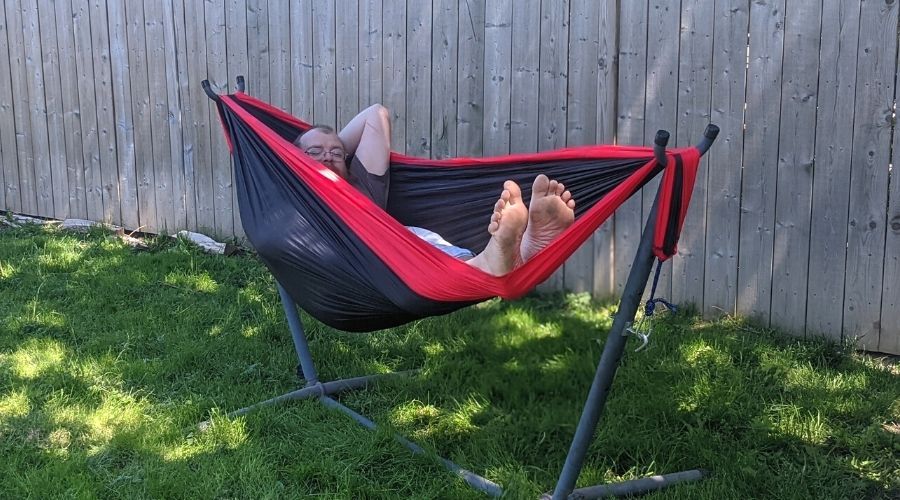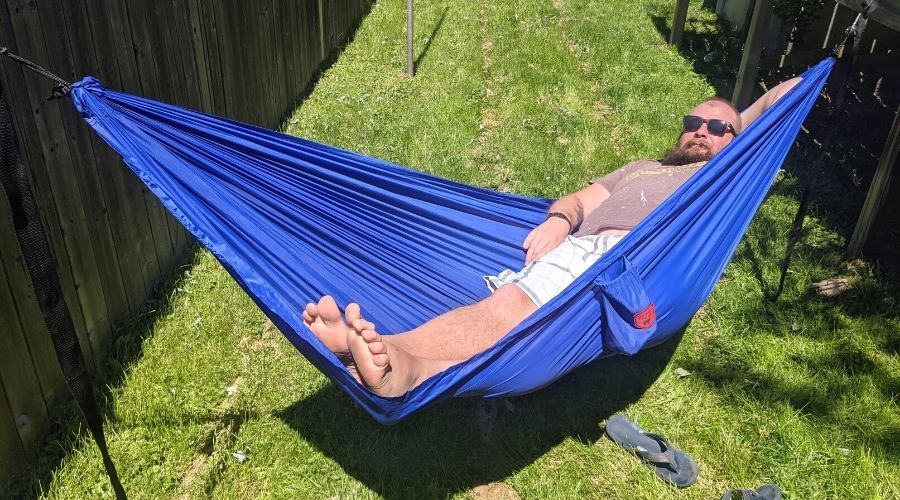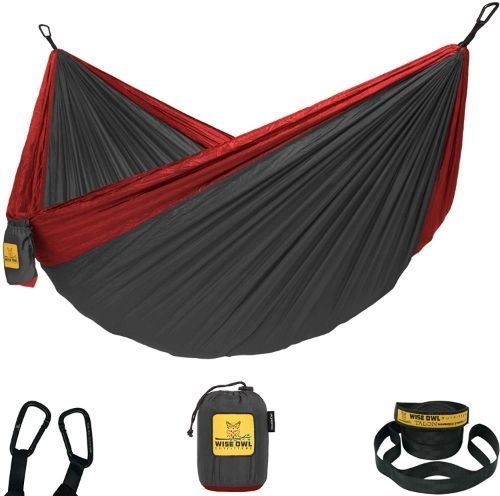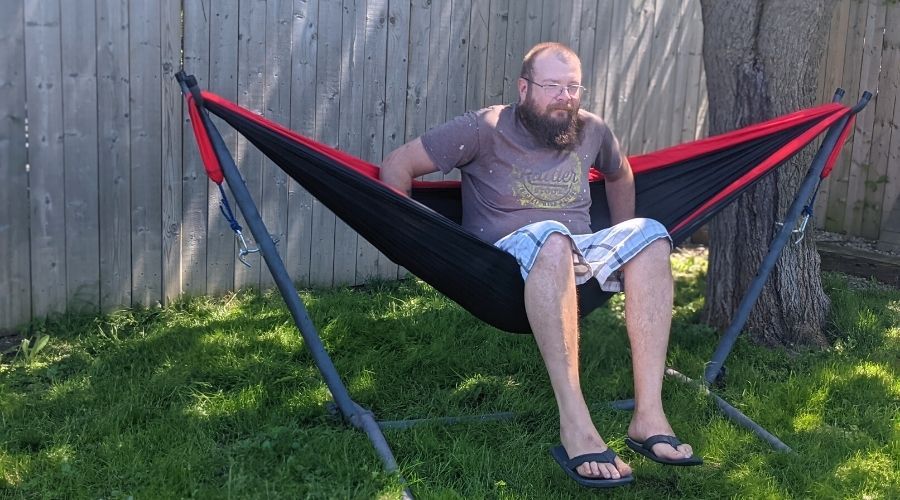Do you enjoy kicking back in your hammock for a relaxing nap? If so, you may find yourself wondering about the possibility of hammock camping or even sleeping in a hammock indoors. You’re not alone! Many people have been trading in their air mattresses and sleeping pads for hammocks. There are even people switching from a standard mattress to a hammock for their at-home sleeping solution. In this article, we’re going to look at how to sleep in a hammock properly, the benefits of sleeping in a hammock and what gear you need to get started.
Is It Safe to Sleep in a Hammock Every Night?
The biggest question that many people have about sleeping in a hammock is whether it’s a safe alternative. The idea of sleeping in a hammock isn’t new. Looking back through history, we can see hammocks being used regularly as a cheap and portable sleeping alternative. One of the best-known examples is the use of hammocks for those living at sea in the Navy.
For the average person, there is no evidence supporting the idea that sleeping in a hammock is unsafe if done properly. This means choosing the right hammock, hanging the hammock properly and using the best sleeping positions. Are you new to sleeping in a hammock? We are going to address each of these concerns in this article so that you can enjoy your hammock safely.
If you have any existing back injuries or nerve problems, it's recommended that you speak with a doctor before making the switch. While some conditions will benefit from the sleeping position of the hammock, allowing you to get a night of better sleep, others can be made worse.
What Are the Benefits of Sleeping in A Hammock?
The rise of popularity of hammock camping and hammock use around the home has been encouraged by the growing interest shown by the scientific and medical communities. There have been several studies conducted to find the benefits of sleeping in a hammock as well as the potential complications that may be faced from sleeping in a hammock incorrectly or for an extended period.
On the most basic level, sleeping in a hammock has two big benefits to consider. It's a low-cost alternative to expensive mattresses, cots, and bed frames. Also, it is a highly portable solution for those that are travelling and concerned about having enough space for all their gear. However, there are many other benefits to consider.
Researchers have found that the gentle rocking motion of a hammock can help you to enjoy a deeper, more restful sleep. This can be compared to the calming effect that babies experience when being rocked to sleep. For those that are having a harder time falling asleep, this may also help to calm and relax the body enough to help manage insomnia.
Another claim made by those who are fans of sleeping in a hammock is that the flexible sleeping surface reduces the pressure that older or worn-out mattresses put on our pressure points. In doing so, it allows you to wake up without the aches and pains that you may have otherwise felt. It should be noted, however, that newer mattresses are also designed to relieve this pressure.
Other benefits that are often discussed, but still require further research to confirm, include reduced stress levels, improved blood circulation from the elevation of the upper body and better mental focus.
What Is the Best Hammock to Sleep In?
When selecting a hammock for sleeping in, you want to choose a solid style of hammock as opposed to the open rope hammocks. This prevents unnecessary pressure points from the ropes of the hammock causing aches and pains throughout the night as well as the signature 'waffle pattern' on your face in the morning.
Fabric hammocks such as the tightly woven Brazilian hammock or a nylon camping hammock are often preferred as they provide a comfortable and secure sleeping surface. If you're sleeping in cooler temperatures, adding an underquilt to your hammock will work to trap and retain your body heat, keeping you warm all night. On warmer nights, both hammock styles are highly breathable.
If you need a flay-lay hammock, stick with a camping-style bridge hammock. Basic fabric hammocks with spreader bars are less stable. Additionally, the firm and stretched fabric on these hammocks don’t offer the same flexibility to cradle the body for comfort.
The Wise Owl Outfitters Double Camping Hammock is a great option for those that are interested in experimenting with sleeping in a hammock. The fabric is soft and comfortable for sleeping while the double-width provides plenty of fabric for stretching out. Measuring 10’ in length, it's suitable for the average person (although it may not be long enough for those that are taller than 6’). This is also a low-cost option, making it easier to make the commitment for the first time.
Wise Owl Outfitters Double Camping Hammock
This lightweight camping hammock made from soft yet strong parachute nylon is low cost, easy to set up, and incredibly comfortable for daytime use and sleeping through the night.
What's the Best Sleeping Position in a Hammock?
Hammocks are designed to encourage you to sleep on your back by slightly hugging the body, holding you in place. Traditional style hammocks cocoon the body, making it difficult to roll over onto your side or stomach. Flay-lay hammocks (or bridge hammocks) allow more flexibility for your sleeping position.
Getting into the best sleep position starts with hanging your hammock properly. The biggest mistake that is often made is to try to remove the curve of the hammock by tying it as tightly as possible. While this may seem to make sense, the slight curve of the hammock is beneficial for your comfort. This allows enough flexibility to avoid the tight walls of the hammock forcing you into the middle of the hammock and preventing you from stretching out or getting comfortable. Instead, you want to hang your hammock with your straps or chains at a 30-degree angle.
To create the best support for your back to avoid unnecessary aches and pains, you want to sleep on your hammock diagonally. This causes the fabric of your hammock to stretch out in a way that creates a flatter sleeping surface. After sitting in the hammock, place your feet off to one side of the hammock and then adjust your body so that your head comes to rest on the opposite side.
This sleeping position won’t create a completely flat surface, but that’s why it works so well. Your head and feet will be slightly elevated with the curve of the hammock, allowing the hammock to then conform to the natural curve of the spine. This is why so many chiropractors and medical professionals are recommending sleeping in a hammock as an option.
Some hammock sleepers choose to use a small pillow while others find that the hammock itself provides enough support for the head. This is a matter of personal preferences with no right answer. Experiment, sleeping one night with a pillow and one without, and discover which is most comfortable for you. Additionally, some hammock sleepers find that a small pillow under their knees can help to relieve the pressure from the ridge of the hammock when sleeping diagonally.
Are Hammocks Good for Side Sleepers?
While it's not the optimal position for sleeping in a hammock, you can comfortably sleep on your side. The key to a good night of sleep as a side sleeper is creating a comfortable, flat surface. This can be done either by purchasing a flat-lay camping hammock with spreader bars to hold the hammock flat or by adding a sleeping pad to your traditional hammock. You may also improve your comfort as a side sleeper by using a neck pillow or a pillow between your knees for added support.
Can You Sleep on Your Stomach in a Hammock?
Unlike back and side sleepers, stomach sleepers generally find that the cocoon style of a traditional hammock isn’t comfortable for sleeping. Often, the sides of the hammock cocoon your face or head, making stomach sleepers feel claustrophobic. However, if you invest in a sturdy bridge-style hammock, you can still get comfortable sleeping on your stomach in a hammock.
If you're determined to try sleeping in a more traditional-style hammock, there are a few changes that you can make to improve your chances of being comfortable. First, hang your hammock slightly looser than you would as a back sleeper to create extra sag. This helps to cut back on the amount of cocooning that you will experience. To do this, you may also need to purchase a longer hammock. You can also use a longer pillow or a sleeping pad to help hold the sides out and away from your face.
Your Hammock Sleeping Experience Starts Here
While sleeping in a hammock isn’t the right solution for everyone, it can be done safely by selecting the right hammock for you and your sleeping style, hanging it with the optimal tension and learning how to sleep in a hammock properly. While the Wise Owl Outfitters Double Camping Hammock is our top pick for hammock sleeping, you can adjust nearly any traditional fabric hammock to work using the tips and tricks that we have outlined.
While I personally still prefer to sleep on my traditional mattress when I'm resting at home, I highly recommend the experience of sleeping in a hammock for anyone interested in experimenting at home or on the road.




